Protecting Protected Health Information (PHI) is an essential commitment in the healthcare industry, not just a requirement under HIPAA. Unauthorized disclosures of PHI can lead to severe consequences for both patients and healthcare providers. At UT Health San Antonio, incorporating these practices into daily routines is crucial for maintaining patient privacy.
When dealing with paper records, always verify that the document containing PHI is being handed to the correct patient by confirming their name and date of birth. When sending PHI via fax, ensure the accuracy of the recipient’s fax number, include a cover sheet with a confidentiality disclaimer, and only include the necessary information. When sending PHI via email, double-check the recipient’s email address, only include the minimum necessary information, and consider using encryption in the subject line for added security, especially when sending to external recipients. When mailing documents with PHI, verify the patient’s mailing address on the envelope and double-check the document before sending it.
To learn more about safeguarding PHI, visit IHOP 11.1.15: Safeguards for Protected Health Information. By following these guidelines and incorporating best practices into daily routines, healthcare providers can fulfill their ethical duty to safeguard PHI and protect patient privacy.
